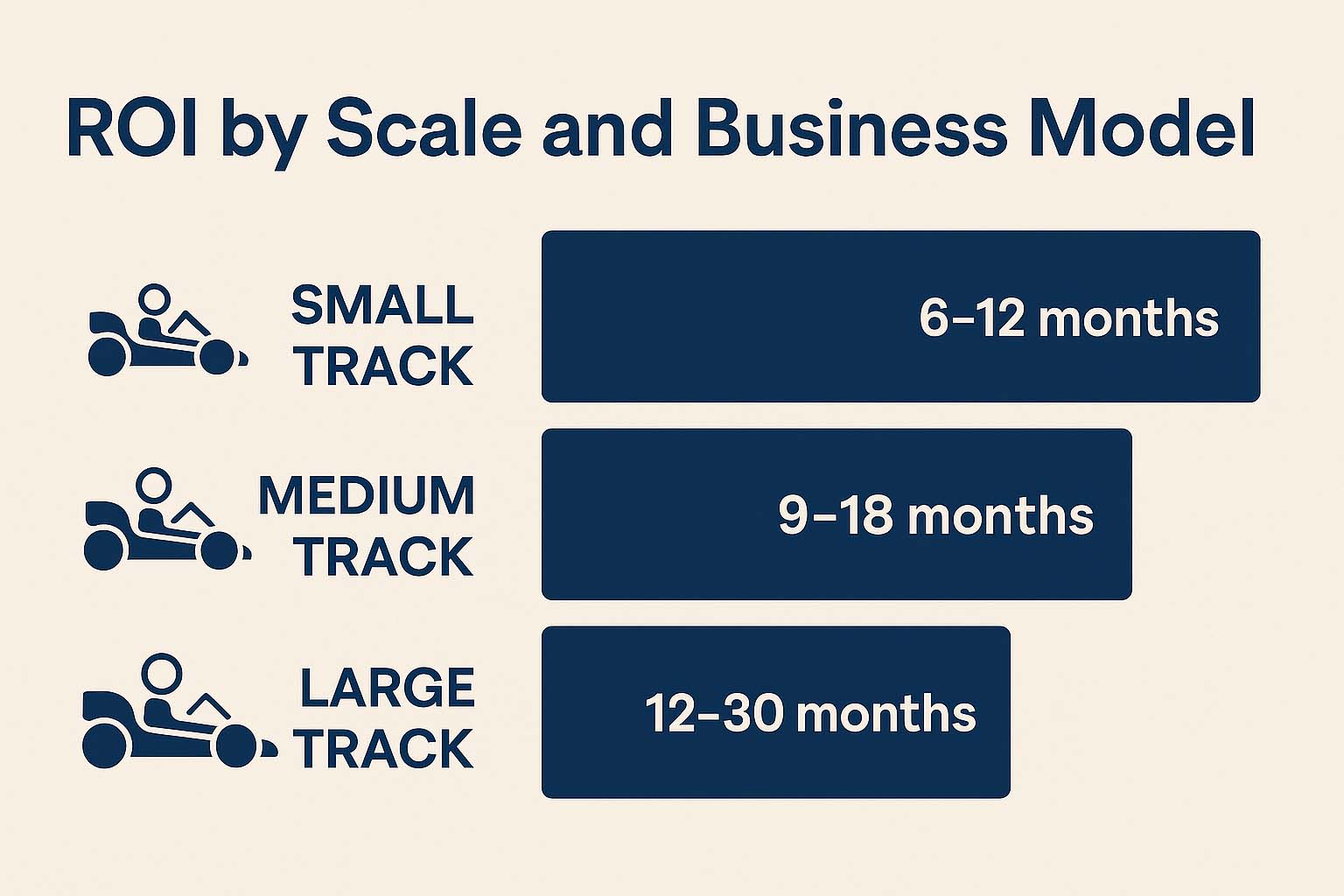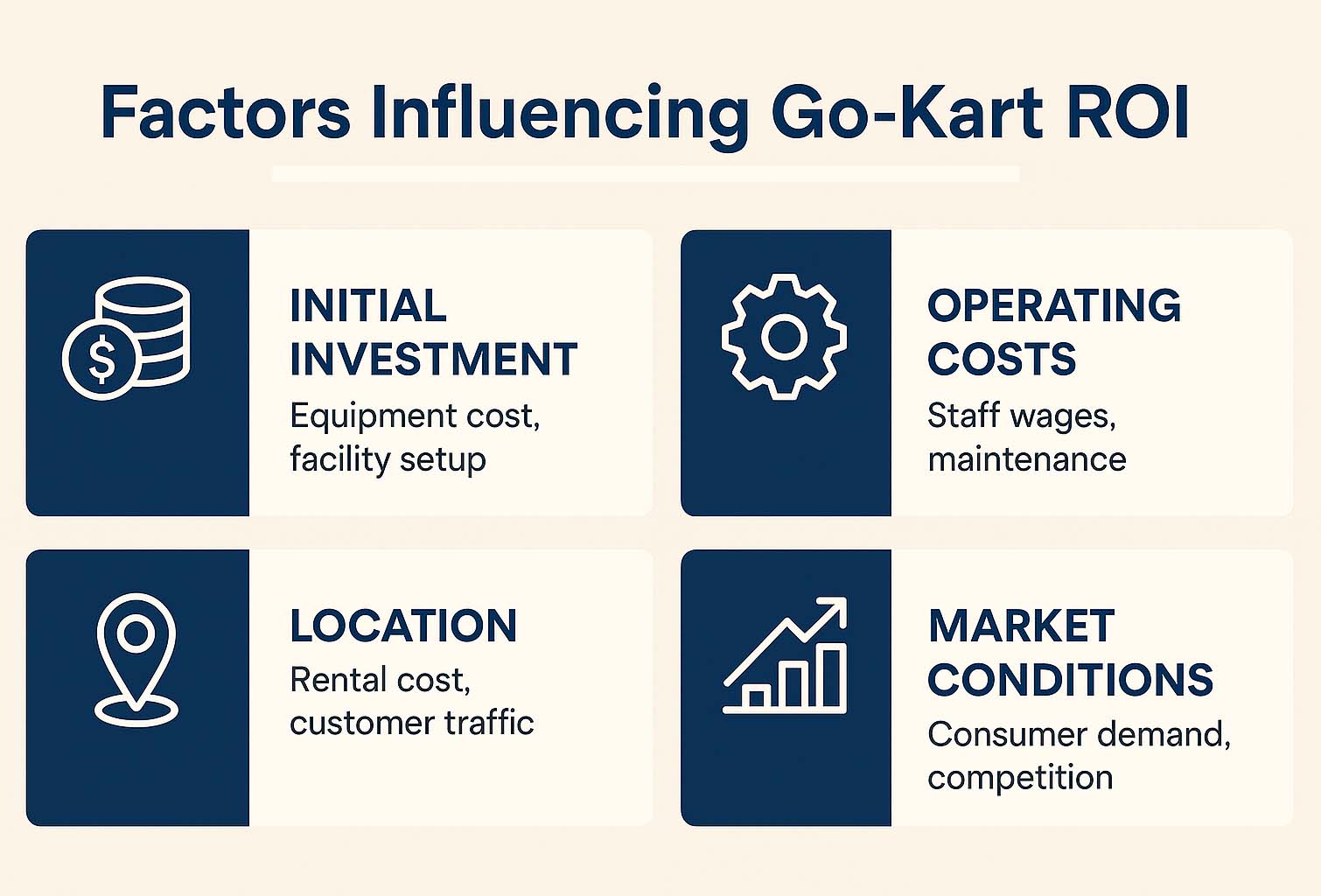1. Introduction — Turning Investment into Return
After learning how much it costs to open a go-kart track, the next question every investor asks is:
“How long will it take to recover my investment?”
The go-kart business is one of the few entertainment ventures with a clear and predictable return cycle.
For most indoor projects, investors can achieve ROI within 6–12 months, depending on the investment size, rent, and operating strategy.
This makes go-karting an attractive business for entrepreneurs seeking stable, repeatable income with manageable risk.
2. What ROI Means in the Go-Kart Industry
ROI (Return on Investment) measures how efficiently your investment generates profit:
ROI = (Net Profit ÷ Total Investment) × 100
But ROI isn’t just a financial number — it reflects your entire business strategy.
From location and rent to marketing and ticket pricing, every decision affects how fast your money comes back.
The goal is not only to minimize costs but also to maximize income efficiency — how quickly each dollar invested brings a return.
3. The Key Factors That Influence ROI
1. Location and Foot Traffic
Foot traffic determines your customer volume.
Tracks near shopping malls, cinemas, or family entertainment centers attract consistent weekend visitors.
However, high-traffic locations come with higher rent, which directly affects ROI — making rent management the most critical variable in your investment plan.
2. Rent and Location Costs — The Real ROI Balancing Act
Rent is often the largest recurring cost for an indoor go-kart business and can make or break your ROI.
However, lower rent doesn’t automatically mean better returns.
A cheap suburban warehouse might save $5,000 per month, but limited traffic could reduce revenue dramatically.
Meanwhile, a high-traffic location may cost more, but it offers visibility and consistent visitor flow.
ROI isn’t about paying the lowest rent — it’s about getting the best rent-to-revenue ratio.
Smart investors focus on rent efficiency and negotiation strategies, not just cost-cutting:
-
Negotiate base rent + revenue sharing with mall operators.
-
Partner with shopping centers that seek family attractions — many offer rent reductions or joint marketing.
-
Choose medium-traffic retail zones with steady weekend flow and lower rent pressure.
-
Keep rent within 10–20% of monthly revenue for healthy cash flow.
The fastest ROI doesn’t come from the cheapest lease — it comes from the smartest lease strategy.
3. Ticket Pricing and Session Time
Shorter sessions with moderate pricing maximize throughput and daily profit.
A balanced pricing system could include:
-
6–8 minute races priced at $8–10 per person
-
Family or group packages (2 adults + 1 child)
-
Weekday promotions to boost off-peak traffic
-
Birthday and corporate event pricing
Pricing should adapt to customer type — focus on volume on weekdays and value on weekends.
4. Equipment Quality and Reliability
Your go-karts are the engine of your ROI.
High-quality, low-maintenance electric go-karts reduce downtime and extend track hours.
A reliable kart can handle 8–12 sessions per day, while a cheap model may break after a few hours.
Investing in professional-grade karts from trusted manufacturers leads to fewer repairs, smoother operations, and faster ROI.
Learn more about choosing the right electric go-kart model for your business.
5. Marketing and Repeat Customers
After your grand opening, continuous marketing keeps revenue stable.
Social media ads, local influencers, and family discounts help sustain traffic.
Better yet, introduce a membership or loyalty system to reward frequent players.
Returning customers can boost your revenue by 30–50%, dramatically shortening the payback period.
4. Example: Fast ROI from a Small Indoor Go-Kart Track
Let’s analyze a realistic small-scale setup — a 400–600㎡ indoor track with 6–8 electric go-karts.
| Parameter | Example Value |
|---|---|
| Total Investment | $30,000 |
| Equipment Cost (Go-Karts + Track Setup)** | $20,000 |
| Rent & Installation | $10,000 |
| Average Visitors per Day | 60–80 |
| Ticket Price per Session | $8 |
| Days Open per Month | 26 |
| Monthly Revenue | ≈ $12,500 – $16,000 |
| Monthly Operating Cost | ≈ $5,000 – $6,000 |
| Monthly Net Profit | ≈ $4,000 – $5,000 |
| Estimated Payback Period | ≈ 6 months |
This example proves that a compact, efficiently managed indoor track can achieve ROI within 6–8 months,
especially when rent and labor costs are controlled.
With just a $30,000 total investment and $20,000 worth of equipment, many operators reach break-even in half a year — one of the fastest payback cycles in the amusement industry.
If you’re still evaluating your initial budget, read our guide on how much it costs to start a go-kart business.
5. ROI by Scale and Business Model

| Track Type | Investment Range (USD) | Typical ROI Period | Estimated Monthly Profit |
|---|---|---|---|
| Small Indoor Track (~500㎡, 6–10 karts) | $25,000–$60,000 | 6–10 months | $4,000–$8,000 |
| Medium Track (~2500㎡, 15–20 karts) | $70,000–$180,000 | 10–14 months | $10,000–$18,000 |
| Large FEC Track (5000㎡+, 25+ karts) | $150,000–$300,000+ | 12–18 months | $20,000–$30,000+ |
Most operators worldwide achieve ROI within the first operational year, especially those in medium-traffic areas with effective rent structures and weekend promotions.
6. How to Accelerate ROI
1️⃣ Negotiate Smart Rent Deals
Lower base rent or switch to revenue-sharing models.
2️⃣ Add MR or VR Experiences
Premium upgrades allow for higher ticket pricing.
3️⃣ Host Events and Parties
Corporate team-building and birthdays can add 20–30% revenue.
4️⃣ Offer Family and Loyalty Packages
Encourage repeat visits and stable weekday traffic.
5️⃣ Maintain Equipment Regularly
Downtime kills ROI — plan preventive maintenance.
6️⃣ Collaborate with Nearby Attractions
Cross-promotions with arcades or trampoline parks bring shared traffic.
Looking for an even higher ROI? Explore our guide to MR (Mixed Reality) Go-Kart tracks
7. Common Mistakes That Delay ROI
-
Choosing low-rent areas with poor visibility
-
Overspending on décor rather than layout
-
Buying unreliable equipment
-
Ignoring marketing after the first month
-
Misjudging cash flow and rent cycles
ROI success depends on operational discipline — not just capital.
8. ROI Synergy with Other FEC Attractions
Instead of comparing ROI across different attractions,
many successful investors combine go-karting with other entertainment products
to create a stronger and more profitable Family Entertainment Center (FEC).
Go-karting often acts as the anchor attraction — it draws families, increases visit duration, and boosts spending across the venue.
Once customers arrive for racing, they naturally explore other zones such as:
-
Arcade and redemption machines
-
Children’s soft play structures
-
VR or MR simulators
-
Café or snack areas
This synergy model increases the average revenue per visitor and improves the overall ROI for the entire venue.
Go-karts are not competitors to other attractions — they are the magnet that drives foot traffic and raises profitability across all entertainment areas.
9. Regional ROI Differences
ROI varies by region due to rent, labor, and consumer spending patterns.
However, even within the same continent, city-level differences can be dramatic —
meaning investors should evaluate not just countries, but specific metropolitan areas.
-
Southeast Asia / Middle East:
Low rent and strong family entertainment demand lead to ROI in 6–9 months.
Indoor electric go-karts are especially popular in shopping malls and mixed-use leisure complexes. -
Europe / North America:
Higher rent and labor costs often extend ROI to 10–14 months,
but higher ticket prices ($12–20 per session) and corporate events ensure steady profitability. -
Latin America:
Moderate setup cost and a rapidly growing middle-class spending capacity.
ROI usually falls within 10–15 months, depending on tourist flow and mall partnerships. -
Africa:
While the overall entertainment market is smaller,
several urban hubs — such as Johannesburg, Lagos, Nairobi, and Cairo — show very strong returns.
In these cities, high-income families and tourism centers can achieve ROI in 8–10 months,
often outperforming other developing regions.
The key takeaway:
City-level spending power matters more than national averages.
A carefully chosen metropolitan site can double your revenue potential — even in emerging markets.
10. Conclusion — Profitability Through Smart Planning
So, how long does it really take to achieve ROI in a go-kart business?
For most investors:
6–12 months for small and medium tracks,
12–18 months for larger facilities.
The exact payback depends on how you balance rent, customer traffic, and equipment performance.
Every decision — from site selection to ticket pricing — affects how quickly you reach profitability.
By choosing reliable suppliers, negotiating smarter leases, and building strong weekend demand,
you can create a go-kart business that not only entertains but delivers consistent profit.
If you’d like a customized ROI plan for your location, contact Wonka Playground.
We help investors worldwide design, install, and operate profitable indoor go-kart tracks with short payback cycles and high returns.

